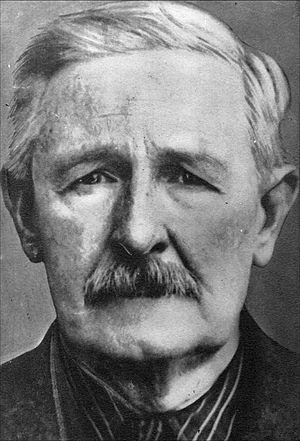Donald Alaster Macdonald facts for kids
Donald Alaster Macdonald (born June 6, 1859 – died November 23, 1932) was a famous Australian journalist and writer. He loved nature and wrote many books about it. People knew him by his pen names, like 'Observer'. He was so well-known that he's in the Melbourne Press Club's Australian Media Hall of Fame. He helped make learning about Australian plants and animals popular for everyone.
Contents
Growing Up in Australia
Donald Macdonald was born in Fitzroy, Victoria, a suburb of Melbourne. His father was also named Donald Macdonald and had Scottish-Canadian family roots. His mother was Margaret Harris.
Donald went to the state school in Keilor. In 1876, he became a pupil-teacher there. This means he helped teach younger students while still learning himself. Later, he started working for newspapers. He first joined The Corowa Free Press and then, in 1881, he moved to the big Melbourne Argus newspaper.
In 1883, Donald married Jessie Seward at Scots' Church, Melbourne. Jessie came from a well-known family in the Rochester area of Victoria. They had one daughter, Jessie Elaine, who also became a writer and traveler. She used the pen name 'Taunton Vale'.
Donald Macdonald's Career
Donald Macdonald became a very important journalist. He wrote about many different topics.
Sports Reporting
Using his pen name 'Observer', Donald became famous for writing about cricket and Australian rules football. He changed how sports were reported. Before him, reports were often just a list of what happened. Donald made his reports exciting and vivid, like you were right there watching the game!
War Correspondent
Donald Macdonald was the first Australian to report on a war from the battlefield. He was a war correspondent during the South African War. During this war, he was stuck in a place called Ladysmith while it was under attack.
His reports from Ladysmith were sent all the way back to Australia. They were published in the Argus newspaper. Later, these reports were put into a book called How we kept the flag flying: The story of the siege of Ladysmith. He returned to Australia in 1900.
Nature Writing
Donald Macdonald also loved nature. He started a weekly column in the Argus newspaper called 'Nature Notes and Queries'. In 1909, this column was expanded to 'Notes for Boys'.
He wrote several books about nature, especially for young people. His book Bush Boy's Book (1911) was very popular. It was reprinted many times. He also wrote a nature book for children called At the End of the Moonpath (1922). After he passed away, his daughter collected some of his writings in a book called The Brooks of Morning (1933).
Donald also put together a Tourists' Handbook of Australia (1905). He even wrote a novel, The Warrigal's Well (1901), with another writer named John F. Edgar.
Later Life and Legacy
Donald Macdonald passed away at his home in Black Rock, Victoria, a seaside suburb of Melbourne, on November 23, 1932. He was survived by his daughter.
Donald Macdonald Park
To remember him, the Sandringham local council bought land in Black Rock in 1937. They turned it into a bird sanctuary and named it 'Donald Macdonald Park'. Today, this park has a playing field, a skate park, a playground, and a scout den.
Memorial Bird Bath
In 1939, a special memorial was put in the park. It was a large bird bath with a bronze picture of Donald Macdonald on it. Many readers of The Argus newspaper helped pay for it. His daughter, who had just returned from England, helped unveil it.
The plaque on the bird bath says: "Donald MacDonald, friend of the creatures of the wild, chose this district in which to live and to end his days. Born at Fitzroy 1857, died at Black Rock 1932. Erected by readers of his "Nature Notes" in the Argus."
You can find this memorial bird bath at the western end of the park, on Haydens Road.
Books by Donald Macdonald
- Gum boughs and wattle blooms (1888)
- How we kept the flag flying: The story of the siege of Ladysmith (1900)
- The Warrigal's Well (1901), a novel written with John F. Edgar
- Tourists' Handbook of Australia (1905)
- Bush Boy's Book (1911)
- At the end of the moonpath (1922) – the money raised from this book helped the Royal Children’s Hospital
- The brooks of morning (1933) – put together by his daughter after his death


